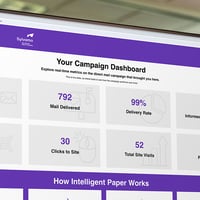Yes, Print Actually Is a Sustainable Marketing Channel

A recent report found that 77% of consumers are likely to reconsider a purchase if a product or brand does not align with their principles on sustainability. This insight is mission-critical for marketers and graphic designers as they weigh the ideal marketing channel to effectively communicate and engage their target audience.
While you may think the importance of a more eco-friendly business model would make print marketing a non-starter for brands, the truth is that print can actually be a sustainable marketing channel that also provides a robust ROI.
Whether the project is direct mail, brochures, catalogs or in-store signage, the trick in creating high-quality, sustainable print marketing materials is understanding how choices like the kind of substrate or even print device can help enhance your sustainability efforts. With this in mind, let’s look at a couple of components to consider to help ensure more sustainable print marketing campaigns.
Prioritize waste reduction via digital print technology
One of the most impactful ways marketers can increase the sustainability of their print marketing campaigns is by choosing digital print technology over offset printing to help reduce waste. Traditional offset printing requires producing large print runs in order to meet the economies of scale that help brands experience ROI on their campaigns.
The issue is that this approach often results in unused copies that need to be warehoused or thrown away, both of which cause significant waste in terms of resources and cost. With digital print technology, marketers can leverage a print-on-demand (POD) approach that allows them to produce small or on-demand print runs in precise quantities the moment marketing materials are needed.
Not only does this help virtually eliminate the likelihood of excess or unused copies, it also fosters a more sustainable use of print resources, like water, ink and paper.
Make the move to more eco-friendly products
There was a time when eco-friendly paper and ink were not capable of producing the same level of quality marketers came to rely on for print marketing communications. But the continued evolution of digital print technology and ink and paper formulations now make it possible to print sustainable, full color marketing materials with exceptional quality.
Selecting paper that is manufactured sustainably or in an environmentally responsible manner is not as challenging as you may think.
For example, papers that are certified by the The Sustainable Forestry Initiative® (SFI®) or the Forest Stewardship Council® (FSC® C168336) ensures that the substrates you print are produced from responsibly harvested forests — in fact, the SFI takes sustainability in paper production one step further by certifying that each step in the paper supply chain is conducted in an eco-friendly manner.
New developments in ink formulation also play a key role in enhancing the sustainability of print marketing, especially when choosing a digital print platform. These inks can be water or soy-based to reduce the amount of harmful chemicals or additives, and new formulations make it possible to achieve the same stunning print and color quality with less colorants.
In addition, solvent-free inks make it easier and less costly to recycle print materials once they’ve reached the end of their service life
Digital integrations can make print marketing more engaging
Integrating digital elements with print marketing can provide some unexpected value in terms of a more sustainable approach to print, particularly in creating more engaging communication that prompts a desired action without subsequent print touchpoints.
For instance, designing print marketing materials like direct mail, brochures, or catalogs with integrations like quick response (QR) codes can help bridge the print and digital worlds to create a more interactive environment that connects with a target audience.
It’s estimated that more than 94 million QR codes will be scanned by the end of 2024. QR codes that open videos, landing pages, coupons or even augmented reality (AR) experiences can produce a more immersive user experience that can help your audience learn about a product or service in a more hands-on way.
This more dynamic approach to marketing communications can increase the likelihood that your audience converts on an offer or completes a purchase, thus reducing the need for subsequent print marketing materials with a similar goal or messaging.
These considerations will help increase the sustainability of your next print marketing campaign, and choosing Accent® Opaque can help you take your sustainability efforts to the next level. Our premium, uncoated paper can be manufactured using post-consumer fibers without sacrificing quality and performance, and we source our paper from renewable forest resources to promote an eco-friendly print model.
Learn more about how Accent paper can help you leverage a more sustainable print marketing channel.





